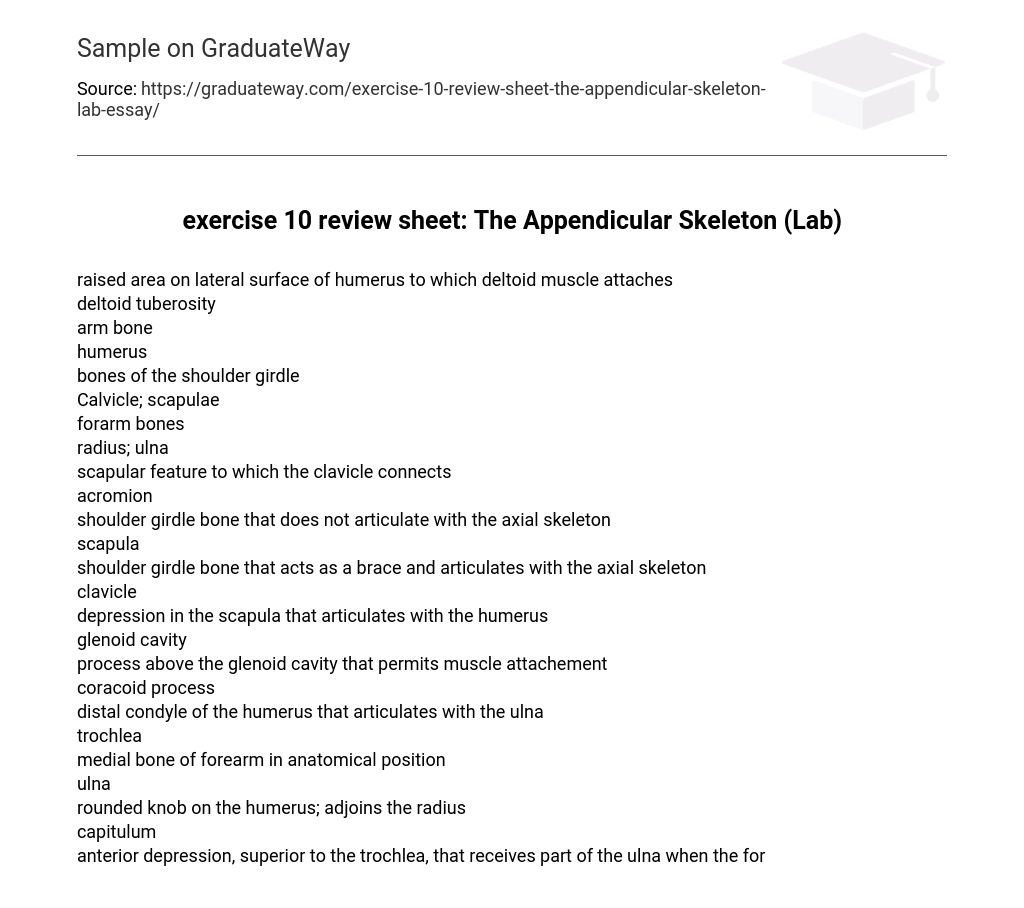raised area on lateral surface of humerus to which deltoid muscle attaches
deltoid tuberosity
bones of the shoulder girdle
Calvicle; scapulae
forarm bones
radius; ulna
scapular feature to which the clavicle connects
acromion
shoulder girdle bone that does not articulate with the axial skeleton
scapula
shoulder girdle bone that acts as a brace and articulates with the axial skeleton
clavicle
depression in the scapula that articulates with the humerus
glenoid cavity
process above the glenoid cavity that permits muscle attachement
coracoid process
distal condyle of the humerus that articulates with the ulna
trochlea
medial bone of forearm in anatomical position
ulna
rounded knob on the humerus; adjoins the radius
capitulum
anterior depression, superior to the trochlea, that receives part of the ulna when the forearm is flexed
coronoid fossa
heads of these bones form the knuckles
metacarpals
small bump often called the “funny bone”
medial epicondyle
how is the arm held clear of the top of the thoracic cage?
the clavicle acts as a brace to hold the scapula & arm away from the top of the thoracic cage
what is the total number of digits in the hand
14
what is the total number of carpals in the wrist?
8
name the carpals (medial to lateral) in the proximal row
1. Pisiform
2. triangular
3. lunate
4. scaphoid
in the distal row, the carpals are (medial to lateral)
1. Nomate
2. capitate
3.trapezoid
4. trapezium
pectoral girdle (3)
1. flexibility most important
2. lightweight
3. insecure axial and limb attachements
pelvic girdle (3)
1. massive
2. secure axial and limb attachments
3. weight-bearing most important
what organs are protected, at least in part, by the pelvic girdle?
small intestine, rectum, uterus, urinary bladder
Distinguish between the true pelvis and false pelvis?
1. False: bounded by alea of the ilia. Supports abdominal viscera.
2. true: entirely surrounded by bone. Laterally and anteriorly
rough projection that supports body weight when sitting
ischial tuberosity
point where the hip bone that receives the head of the thigh bone
Acetabulum
superiormost margin of the hip bone
iliac crest
point where the hip bones join anteriorly
pubic symphysis
longest, strongest bone in the body
femur
thin, lateral bone
fibula
permits passage of the sciatic nerve
greater sciatic notch
notch located inferior to the ischial spine
lesser sciatic notch
point where the patellar ligament attaches
tibial tuberosity
medial ankle projection
medial malleolus
lateral ankle projection
later malleolus
bones forming the instep of the foot
metatarsals
opening in hip bones formed by the pubic and ischial rami
obuturator foramen
sites of muscle attachment on the proximal femur
gluteal tuberosity; greater & lesser trochanters
tarsal bone that “sits” on the calcaneus
talus
weight-bearing bone of the leg
tibia
Remember! This essay was written by a student
You can get a custom paper by one of our expert writers
Order custom paper
Without paying upfront





